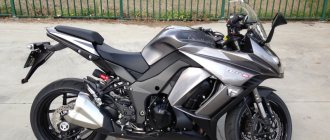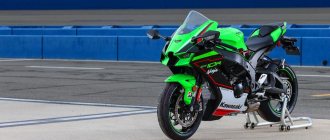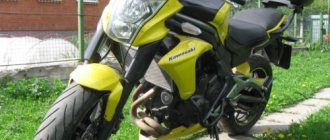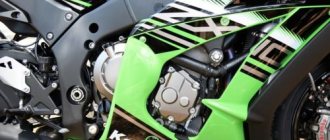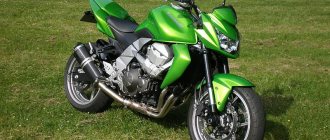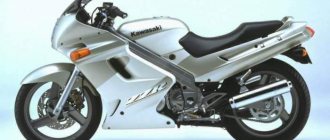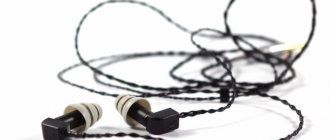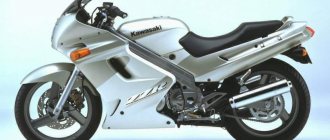| Kawasaki Z1000 (2003-2006) | Kawasaki Z1000 (2007-2009) | Kawasaki Z1000 (2010-2013) | Kawasaki Z1000SX/Ninja 1000 (2011-2013) |
| Kawasaki Z1000 (2014-2016) | Kawasaki Z1000SX/Ninja 1000 (2014-2016) | Kawasaki Z1000 (2017-2020) | Kawasaki Z1000R (2017-2020) |
| Kawasaki Z1000SX/Ninja 1000 (2017-2019) | Kawasaki Ninja 1000SX (2020+) |
Kawasaki Z1000 naked model
was introduced in 2003 as a successor to the legendary Z-series, produced in the 70s of the last century. The model was based on a steel frame, plastic elements from the sports Kawasaki ZX-6R and a derated engine from the Kawasaki ZX-9R with a volume of 953 cm³.
In 2007, the model underwent its first major restyling, receiving an updated appearance and versions with ABS. The front brake is now equipped with radial calipers. Maximum power, compared to the previous generation, is reduced to 125 hp.
2010 was marked by the second restyling of the Kawasaki Z1000 model. The motorcycle gets new plastic and dashboard designs, an aluminum frame, fully adjustable front suspension and monobloc front calipers. The new engine of increased volume (1043 cm³) already produces 138 hp.
Since 2011, the Z1000 line has been supplemented by a plastic version - Kawasaki Z1000SX
. The model is positioned on the market as a sports tourer, which is also offered with touring accessories - panniers, etc.
In 2014, the model undergoes a new restyling, receiving a more aggressive appearance, LED optics and an increased (up to 310 mm) diameter of the front brake discs. Maximum engine power increases to 142 hp. The model also gets a slipper clutch and an Assist & Slipper clutch.
For the 2021 model year, Kawasaki is completely removing the non-ABS version from the lineup and slightly changing the appearance of the motorcycle (mainly paint, logo design, etc.). The rear suspension settings are changing. Performance version appears - Kawasaki Z1000R
. It features Brembo front brakes, Ohlins rear suspension and a proprietary Akrapovic exhaust system (in the R Edition Performance version). The Z1000SX / Ninja 1000SX version also undergoes changes, the main of which is new electronic equipment (KTRC, Power Modes, KIBS, IMU).
In 2021, the Z1000SX / Ninja 1000SX modification receives a new electronic system - KCMF (Kawasaki Cornering Management Function).
For 2021, Kawasaki is introducing a new version of the Z1000SX, which now has a single name in all markets - Kawasaki Ninja 1000SX
. The main changes compared to the previous generation were a new exhaust, changed weight and size parameters and new electronic equipment in the form of electronic cruise control, Smartphone connectivity and a color TFT display.
The 2021 Kawasaki Ninja 1000SX gets a quick shifter as standard.
Kawasaki Z1000 / Ninja 1000SX: electronic equipment
- ABS - since 2007
- KTRC (Kawasaki TRaction Control) 3-Mode - Z1000SX / Ninja 1000SX (from 2021)
- Power Modes - Z1000SX / Ninja 1000SX (from 2021)
- KIBS (Kawasaki Intelligent anti-lock Brake System) - Z1000SX / Ninja 1000SX (from 2021)
- IMU (Inertial Measurement Unit) - Z1000SX / Ninja 1000SX (since 2017)
- KCMF (Kawasaki Cornering Management Function) - Z1000SX / Ninja 1000SX (from 2021)
- Electronic Cruise Control - Z1000SX / Ninja 1000SX (from 2020)
- Smartphone connectivity - Z1000SX / Ninja 1000SX (from 2020)
- TFT Color Display - Z1000SX / Ninja 1000SX (from 2021)
- KQS (Kawasaki Quick Shifter) - Z1000SX / Ninja 1000SX (from 2021)
The main competitors of the Kawasaki Z1000 in the class
:
- Yamaha FZ1/Yamaha MT-10
- Honda CB1000R
- Suzuki GSX-S1000
Brief history of the model
- 2003 - start of production and sales of the model. First generation.
Model
: Kawasaki Z1000 (all regions).
Factory designation
: ZR1000-A1.
- 2004 - no significant changes.
Model
: Kawasaki Z1000 (all regions).
Factory designation
: ZR1000-A2.
- 2005 - the model receives an immobilizer system.
Model
: Kawasaki Z1000 (all regions).
Factory designation
: ZR1000-A3.
- 2006 - no significant changes.
Model
: Kawasaki Z1000 (all regions).
Factory designation
: ZR1000-A6F.
- 2007 - restyling of the model. Second generation
. The model receives an updated appearance, radial calipers at the front, different rear suspension settings and a reduction in fuel tank capacity from 19.0 → 18.5 liters. Maximum power decreases: 127 → 125 hp.
Model
: Kawasaki Z1000 + ABS (all regions).
Factory designation
: ZR1000-B7F + ZR1000-C7F.
- 2008 - no significant changes.
Model
: Kawasaki Z1000 + ABS (all regions).
Factory designation
: ZR1000-B8F + ZR1000-C8F.
- 2009 - no significant changes.
Model
: Kawasaki Z1000 + ABS (all regions).
Factory designation
: ZR1000-B9F + ZR1000-C9F.
- 2010 - restyling of the model. Third generation.
The model receives a new external, aluminum frame, a larger engine (953 → 1043 cm³), fully adjustable front forks, monoblock front calipers and a reduced fuel tank capacity (18.5 → 15.0 l). Maximum power increases: 125 → 138 hp.
Model
: Kawasaki Z1000 + ABS (all regions).
Factory designation
: ZR1000-DAF + ZR1000-EAF.
- 2011 - appearance of the Kawasaki Z1000SX modification (sold in the North American market as the Kawasaki Ninja 1000).
Model
: Kawasaki Z1000 + ABS;
Kawasaki Z1000SX / Ninja 1000 + ABS (all regions). Factory designation
: ZR1000-DBF + ZR1000-EBF; ZX1000GBF + ZX1000HBF.
- 2012 - no significant changes.
Model
: Kawasaki Z1000 + ABS;
Kawasaki Z1000SX / Ninja 1000 + ABS (all regions). Factory designation
: ZR1000-DCF + ZR1000-ECF; ZX1000GCF + ZX1000HCF.
- 2013 - no significant changes.
Model
: Kawasaki Z1000 + ABS;
Kawasaki Z1000SX / Ninja 1000 + ABS (all regions). Factory designation
: ZR1000-DDF + ZR1000-EDF; ZX1000GDF + ZX1000HDF.
- 2014 - restyling of the model. Fourth generation.
The model receives an updated appearance, LED optics, a slipper clutch (Assist & Slipper clutch), an increase in the diameter of the front brake discs (300 → 310 mm), an increase in fuel tank capacity (15.0 → 17.0 l) and an increase in maximum power (138 → 142 hp).
Model
: Kawasaki Z1000 + ABS;
Kawasaki Z1000SX / Ninja 1000 + ABS (all regions). Factory designation
: ZR1000-FEF + ZR1000-GEF; ZX1000LEF + ZX1000MEF.
- 2015 - no significant changes.
Model
: Kawasaki Z1000 + ABS;
Kawasaki Z1000SX / Ninja 1000 + ABS (all regions). Factory designation
: ZR1000-FFF + ZR1000-GFF; ZX1000LFF + ZX1000MFF.
- 2016 - no significant changes. The Z1000SX / Ninja 1000 version is now offered only in the ABS version.
Model
: Kawasaki Z1000 + ABS;
Kawasaki Z1000SX / Ninja 1000 ABS (all regions). Factory designation
: ZR1000-FGF + ZR1000-GGF; ZX1000MGF.
- 2017 - restyling of the model. Fifth generation.
The appearance is slightly updated, the rear suspension settings are changed. A Performance version appears - Kawasaki Z1000R. Versions without ABS are no longer produced.
Model
: Kawasaki Z1000 ABS;
Kawasaki Z1000SX / Ninja 1000 ABS (all regions). Factory designation
: ZR1000-HHF; ZX1000WHF.
- 2018 - no significant changes.
Model
: Kawasaki Z1000 ABS;
Kawasaki Z1000SX / Ninja 1000 ABS (all regions). Factory designation
: ZR1000-HJF; ZX1000WJF.
- 2019 - no significant changes.
Model
: Kawasaki Z1000 ABS;
Kawasaki Z1000SX / Ninja 1000 ABS (all regions). Factory designation
: ZR1000-HKF; ZX1000WKF.
- 2020 - restyling of the Ninja 1000SX version.
Model
: Kawasaki Z1000 ABS;
Kawasaki Ninja 1000SX (all regions). Factory designation
: ZR1000-HLF; ZX1002KLF.
- 2021 - The Ninja 1000SX modification is equipped with a quick shifter.
Model
: Kawasaki Ninja 1000SX (all regions).
Factory designation
: ZX1002KMFNL, ZX1002KMFNN.
- 2022 - no significant changes.
Model
: Kawasaki Ninja 1000SX (all regions).
Factory designation
: ZX1002KNFAL, ZX1002KNFNN, ZX1002KNFAN.
Exterior of Kawasaki Z1000
From the very beginning of production, the Z1000 was positioned as a road-class motorcycle.
The very first Kawasaki Z1000 models (2003–2006) already had a rather stylish look, characteristic of the sports class of motorcycles of that time.
Thoroughbred steel horse.
Side view.
Front view.
Back view.
- the front , with a headlight and tinted windshield that have a lot of sharp corners and sharp bevels. The turn signal indicators are placed separately for better visual perception, and above the front wheel the designers installed a massive wing that protects the driver from water and dirt during bad weather.
- On the side of the motorcycle you can find a minimum of plastic elements. The engine, gearbox cover, radiator, and dual exhaust pipe have open access; at the very top of the technical filling there is a volumetric tank made in the shape of a semicircle with sharp bevels. The driver and passenger seats are separated and installed at different heights. At the same time, the factory version of the bike has a plastic cover under which you can hide the rear seat in case of a solo trip.
- There is also nothing superfluous at the rear of the Kawasaki Z1000 . A small brake light of an unusual angular shape is hidden under the plastic lining of the seats. And underneath there is a separate mount for the license plate (not on the wing, as on many Japanese models, but on three individual brackets).
First restyling
After the first restyling, carried out in 2007, the motorcycle changed somewhat in appearance.
And the first thing that catches your eye is the presence of additional pads on the sides, onto which the designers moved the turn signal indicators.
Side fairings appeared at the front.
The rear mufflers have changed.
Also, to resemble a sports bike, the updated model was made more planted, and its front facing was significantly sharpened.
After 2010
The bike began to look more aggressive.
New plastic design.
Engine of increased volume.
New exhaust system.
The next version of the Kawasaki Z1000, developed in 2010, had minimal visual differences from the previous prototype, and all the manufacturer’s efforts went into technical improvement of the bike.
As a result of such improvements, the Z line was replenished with the flagship model Z1000SX Ninja, equipped with full-fledged LED optics and quite powerful hardware.
Reviews
Kawasaki Z1000 reviews:
Expand Collapse
On the plus side, I can say the following: the engine is simply super. High thrust in all ranges, the engine spins up from the lowest revs. If you accelerate sharply from a stop, then from the first wheelie it is guaranteed, you have to load the front to avoid a wheelie. When accelerating, the engine can spin up to almost 10,500 rpm. The acceleration is simply rapid. Despite the weight of 221 kg, steering is very easy. It’s easy to get into a turn, the main thing is not to put pressure on the steering wheel and let the bike steer, then it’s very easy to take turns. The saddle is comfortable, allows you to change position from flat to lying down. At speeds above 140 you already have to lie down, but you can accelerate to 250 if you change the windshield to an optional one. I drove 230 km/h, but I feel that I can go even faster. It is very stable in cross winds, when friends complain about the wind, I ride comfortably. The speedometer turned out to be more convenient than I thought; it seemed that the data would not be readable in bright sunshine, but I can always monitor both the revolutions and other data.
My second bike, the first was a Yamaha R6, I thought I couldn’t continue riding because it was crazy, I had to sell it. I bought a Z 1000 right away in the season, the first impressions were very positive, a very calm motor, like a tractor you can go 60 in 6th gear and accelerate just as quickly. The passes are short, they could have been made longer. .It’s very comfortable to drive, it handles like a bike, the feeling of confidence is very high. Before that, I bought my brother a Z 750-2009, it is much less convenient and harder to drive, it’s not clear why. The Z1000 is a very successful bike for driving around the city; at traffic lights it does 1 right from the start, albeit at 100 meters). Before buying, I thought that it would blow away, there is such a problem, up to 140 ka everything is normal, then it starts blowing, 175 is already an unpleasant sensation, I don’t need any more. I advise all amateurs and beginners who do not strive for parallel dimensions. There were no breakdowns Like a new motor.
I drove this a little, I really liked it, I especially want to note the clarity and intelligibility of the gearbox and excellent brakes, respect!! I didn’t like the digital instrument panel, it’s not clear what’s flashing on it, my opinion is that nothing better than analog dials has yet been invented, but the bike is super, it steers/accelerates/brakes by 5,
I have a 2007 (model 2007-2009), I bought it from Lekha))) thank you by the way. drove 20 thousand, never had an accident, everything works, there was one warranty case - the clutch rod broke... there is no wind protection, it eats up, especially at the bottom, excellent, I like it... I won’t sell it, I’ll change the chain and sprockets, but I don’t know why - I just bought it, everything is perfect
Dashboard
The first models were equipped with a “tidy” with a pointer-type tachometer.
On the simplest examples of the Japanese sports motorcycle, produced until 2010, a dashboard was installed consisting of:
- round dial of a pointer type , with a maximum value of 13 thousand rpm .
- Rectangular LCD display displaying the speed of the bike and its actual mileage.
- Several light indicators showing: the current gear of the gearbox, the turn signal and high beams on, oil pressure, exceeding the maximum permissible speed, and the state of the engine (Check-engine).
Intermediate version of the panel.
Modern option.
Depending on the year of production of the model, the design of the dashboard changed significantly, and only on the latest samples the dial was replaced with an electronic engine speed indicator.
Specifications
Front and side views.
Back view.
Our handsome boy!
The other side.
| Characteristic | Parameter |
| Motorcycle type | naked |
| Year of issue | 2003+ |
| Frame | steel – Z1000 (2003-2009) aluminum – Z1000 (2010+) |
| engine's type | 4-cylinder, 4-stroke, in-line |
| Working volume | 953 cm³ – Z1000 (2003-2009) 1043 cm³ – Z1000 (2010+) |
| Bore/Stroke | 77.2 x 50.9 mm – Z1000 (2003-2009) 77.0 x 56.0 mm – Z1000 (2010+) |
| Compression ratio | 11.2:1 – Z1000 (2003-2009) 11.8:1 – Z1000 (2010+) |
| Cooling | liquid |
| Number of valves per cylinder | DOHC, 4 valves per cylinder |
| Fuel supply system | injector, 4x Keihin TTK38 - Z1000 (2003-2006, 2010+) injector, 4x Keihin TTK36 Z1000 (2007-2009) |
| Ignition type | digital transistor |
| Maximum power | 127.0 hp (93.4 kW) at 10,000 rpm - maximum power for Z1000 (2003-2006) 125.0 hp. (92.0 kW) at 10,000 rpm - maximum power for Z1000 (2007-2009) 138.0 hp. (101.5 kW) at 9600 rpm - maximum power for Z1000 (2010-2013), Z1000SX / Ninja 1000 (2011-2013) 142.0 hp (104.5 kW) at 10,000 rpm - maximum power for Z1000 (2014+), Z1000SX / Ninja 1000 (2014+) |
| Maximum torque | 95.6 Nm (9.7 kg*m) at 8000 rpm - maximum torque for Z1000 (2003-2006) 98.7 Nm (10.1 kg*m) at 8200 rpm - maximum torque for Z1000 ( 2007-2009) 110.0 Nm (11.2 kg*m) at 7800 rpm - maximum torque for Z1000 (2010-2013), Z1000SX / Ninja 1000 (2011-2013) 111.0 Nm (11.3 kg *m) at 7300 rpm – maximum torque for Z1000 (2014+), Z1000SX / Ninja 1000 (2014+) |
| Transmission | 6-speed |
| type of drive | chain |
| Front tire size | 120/70ZR-17 (58W) |
| Rear tire size | 190/50ZR-17 (73W) |
| Front brakes | 2 discs, 300 mm, 4-piston calipers – Z1000 (2003-2006) 2 discs, 300 mm, 4-piston radial calipers (optional ABS) – Z1000 (2007-2009) 2 discs, 300 mm, 4-piston radials monoblock calipers (optional - ABS) – Z1000 (2010-2013), Z1000SX / Ninja 1000 2 discs, 310 mm, 4-piston radial monoblock calipers (optional - ABS) – Z1000 (2014+) |
| Rear brakes | 1 disc, 250 mm, 1-piston caliper – Z1000 (2003-2006) 1 disc, 250 mm, 1-piston caliper (optional - ABS) – Z1000 (2007+) |
| Front suspension | 41 mm inverted fork (preload and rebound adjustment), 120 mm travel – Z1000 (2003-2009) 41 mm inverted fork (all adjustments), 120 mm travel – Z1000 (2010+) |
| Rear suspension | pendulum with monoshock absorber (adjustable preload and rebound), stroke - 138 mm - Z1000 (2003-2006), Z1000 (2010-2013) pendulum with monoshock absorber (adjustable preload and rebound), stroke - 150 mm - Z1000 (2007-2009) pendulum with monoshock absorber (adjustable preload and rebound), stroke - 122 mm - Z1000 (2014-2016) pendulum with monoshock absorber (adjustable preload and rebound), stroke - 135 mm - Z1000 (2017+) pendulum with monoshock absorber (adjustable preload and rebound), travel – 144 mm – Z1000SX / Ninja 1000 (2017+) |
| Motorcycle length | 2080 mm – Z1000 (2003-2006) 2090 mm – Z1000 (2007-2009) 2095 mm – Z1000 (2010-2013) 2045 mm – Z1000 (2014+) 2105 mm – Z1000SX / Ninja 1000 (2011-2016) 21 00 mm – Z1000SX / Ninja 1000 (2017+) |
| Motorcycle width | 770 mm – Z1000 (2003-2006) 780 mm – Z1000 (2007-2009) 805 mm – Z1000 (2010-2013) 790 mm – Z1000 (2014+), Z1000SX / Ninja 1000 |
| Motorcycle height | 1055 mm – Z1000 (2003-2006), Z1000 (2014+) 1065 mm – Z1000 (2007-2009) 1085 mm – Z1000 (2010-2013) 1170 mm – Z1000SX / Ninja 1000 (2011-2016) 1185 mm – Z10 00SX/ Ninja 1000 (2017+) |
| Wheelbase | 1420 mm – Z1000 (2003-2006) 1445 mm – Z1000 (2007-2009), Z1000SX / Ninja 1000 (2011-2016) 1440 mm – Z1000 (2010-2013), Z1000SX / Ninja 1000 (2017+) 1435 mm – Z1000 (2014+) |
| Seat height | 820 mm – Z1000 (2003-2009) 815 mm – Z1000 (2010-2013), Z1000 (2014+), Z1000SX / Ninja 1000 |
| Minimum ground clearance (clearance) | 145 mm – Z1000 (2003-2006) 160 mm – Z1000 (2007-2009) 140 mm – Z1000 (2010-2013) 125 mm – Z1000 (2014+) 135 mm – Z1000SX / Ninja 1000 (2011-2016) 130 mm – Z1000SX / Ninja 1000 (2017+) |
| Acceleration to 100 km/h | 3.03 sec - Z1000 (2003-2006) 3.36 sec - Z1000 (2007-2009) 3.05 sec - Z1000 (2010-2013) 3.24 sec - Z1000 (2014+) 2.91 sec - Z1000SX / Ninja 1000 (2011-2013) 3.01 sec – Z1000SX / Ninja 1000 (2014+) |
| Maximum speed | 249 km/h |
| Gas tank capacity | 19.0 L – Z1000 (2003-2006), Z1000SX / Ninja 1000 18.5 L – Z1000 (2007-2009) 15.0 L – Z1000 (2010-2013) 17.0 L – Z1000 (2014+) |
| Motorcycle weight (curb) | 221 kg – Z1000 (2003-2006) 228 kg – Z1000 (2007-2009) 232 kg – Z1000 ABS (2007-2009) 218 kg – Z1000 (2010-2013) 221 kg – Z1000 ABS (2010-2013) 220 kg – Z1000 (2014+) 221 kg – Z1000 ABS (2014+) 228 kg – Z1000SX / Ninja 1000 (2011-2016) 231 kg – Z1000SX / Ninja 1000 ABS (2011-2016) 235 kg – Z1000SX / Ninja 1000 ABS (20 17+ ) |
The first prototype of the Kawasaki Z1000 2003. It is equipped with a 950 cc gasoline engine with a capacity of 132 horsepower and a 6-speed manual transmission, which allows the motorcycle to reach the first hundred in just 3.4 seconds.
In 2003, the Z1000 was equipped with derated engines from the Kawasaki ZX-9R.
At the same time, the maximum speed indicator of this model is 245 km/h , which is quite enough for confident driving on country highways.
On the restyled version of the bike, the capacity of the four-stroke engine was reduced to 125 horses , which reduced the maximum speed of the motorcycle to 235 km/h , and increased its acceleration time to hundreds ( 3.7 seconds, instead of 3.3 ). But such a technical change benefited lovers of economy, since a 125-horsepower engine requires only 4–5 liters per 100 km , while more powerful models consume up to 6 liters .
Front wheel brake mechanism.
Flagship version
Engine 142 horsepower.
Exhaust manifold.
Well, on the flagship version of the Z1000SX Ninja you can find the most powerful power unit, with a volume of 1050 cm3 .
At 8–9 thousand revolutions, this engine produces up to 143 horses , thanks to which the bike accelerates to hundreds in just 2.7 seconds , and its maximum speed limit reaches 264 km/h .
But with such characteristics, fuel consumption also increased by an average of 1 liter.
dimensions
All Japanese models of the Z1000 line have fairly restrained dimensions, thanks to which the maneuverability of the motorcycle reaches a very high level.
In length, this model reaches from 2080 mm to 2105 , depending on the version. The width of the bike ranges from 770 to 805 mm, which allows the bike to easily maneuver in heavy traffic.
But the height of the Kawasaki frame can reach as much as 1185 mm , which is why getting on the motorcycle (especially on the passenger seat) is not very comfortable. But otherwise, in terms of overall dimensions, this sports unit is not inferior to city models designed for comfortable movement among traffic flows.
Peculiarities
Brake discs of a motorcycle produced in 2014.
Based on reviews from the owners of this model, it follows that a sports motorcycle has more advantages than disadvantages.
For comparison, the advantages of the Kawasaki Z1000 sample include:
- Great design , even for this year.
- Quick acceleration to hundreds.
- Great top speed.
- Excellent engine displacement , allowing you to not consume too much fuel.
- Restrained price (for the simplest sample, dealers will ask the buyer about 500-600 thousand rubles, and for the flagship version you will have to pay at least one million).
and disadvantages of the model
The “wind deflector” on the front panel fits well into the overall design of the bike, but it doesn’t do any good.
But the only disadvantages of this model are:
- lack of wind protection (due to the minimal amount of plastic cladding).
- digital panel , which is not very convenient compared to its analogue.
- and short gears , which make moving around the city extremely inconvenient.
In fact, the bike turns out to be very practical, and this is the main thing when a motorcycle is purchased specifically for riding, and not for “showing off.”
Price
The price range for the Kawasaki Z1000 is quite wide. The cost is determined based on the year of manufacture, equipment, and condition of the bike (if we are talking about a used motorcycle).
A new Kawasaki 2021 from a dealer costs about 900,000 rubles. The 2021 model can be picked up from the showroom for about 850,000 rubles. For the new R Edition you will have to pay 980,000 rubles.
Much more affordable prices for used offers. Version 2007 can be purchased for 360,000 rubles. in good condition with about 20,000 km mileage. For 510,000 rubles. you can become the owner of the 2011 version without an accident, but with tuning.
Those who want to ride one of the best stripfighters and are ready to buy a used version should pay attention to the natural wear and tear of the motorcycle. If the bike was used on Russian roads, the condition will be much worse than that of an iron horse that has never traveled outside its homeland; in this case, Japanese motorcycle auctions will help solve the problem. You can view auction prices for this model here.
001_MOTO_0910_014
Kawasaki Z1000: roadster, 2010, 1043 cm³, 138 hp, 221 kg, from RUB 516,468.
Kawasaki Z1000: roadster, 2010, 1043 cm³, 138 hp, 221 kg, from RUB 516,468.
Now a completely different type is held in high esteem. Down with prejudices and callous views! Choppers are for pot-bellied, bearded, overly well-fed and therefore unhurried gentlemen with an arrogant look. Of course, there are lovers of such characters, but how can I, young, slender, energetic, progressive and also modest, compare to them? Unless you can get somewhere a suspended silicone belly and a wig with the effect of “four hairs, but half a meter long.” Okay, let's leave chopperism to its apologists. Otherwise they will beat you to death with heavy leather jackets.
005_MOTO_0910_014
The “glass” is also purely stylistic, it is of absolutely no use.
The “glass” is also purely stylistic, it is of absolutely no use.
So, the social-motorcycle experiment ended with quite logical results: most of the interested glances I collected (and a couple of easy but promising acquaintances) belonged to young ladies, energetic and athletic (as evidenced not only by the style of clothing, but also by all kinds of rollerblades, bicycles and other bags with tennis rackets). Yes, if it weren’t a “Zedka” standing next to my table, but some kind of “chrome truck”, I would have collected only punk teenagers and bored ladies of Balzac’s age... Although I still won’t draw parallels, I’ll focus on the motorcycle. The updated, or rather practically brand new, Kawasaki Z1000 has really taken another leap forward from “just a classic” to an “evil naked”. In all respects, it can be safely classified as a street fighter. She seems to be a spiteful woman, but somehow amazingly noble. The facings, painted in white mother-of-pearl with red accents, are set off by a black frame and engine with absolutely cosmic outlines. The picture is completed by a mega-brutal front fork, entirely hidden in a rectangular plastic casing. It seems that one of the key conditions for creating the appearance of the bike was the ban on the use of compasses. Just a ruler and a square! And of course, the last chord that finally attracts the eye to the bike is the mufflers. “Zedki” of previous generations, it should be noted, were also distinguished by “pipe modernity,” but here the designers simply outdid themselves. And how does the device look in metallic chestnut brown color and with a “seat” covered with “python skin”! In general, the appearance of the device is brutal, masculine and noble. What can you do, but it’s very difficult to get away from the usual nicknames “Zedka” and “Kava”. So I won’t bother inventing male names, but remember that this “Kava” is quite a “man”.
First impressions of the motorcycle turned out to be very vague. It seems to be an “evil” naked bike, but to say that the landing “provokes annealing” does not work at all. It is quite comfortable, with a slight tilt forward and, again, a slight shift of the footrests back and up. The fairly wide, almost cross-shaped steering wheel only aggravates this feeling. “I sat down and went to the bakery to get some buns for tea.” The motor behaves in approximately the same manner as the ergonomics. Grumbling softly with two twin mufflers, the device smoothly accelerates without any jerks, explosions or attempts to stall at low throttle, so characteristic of highly accelerated engines. He is absolutely controlled, predictable and adequate in his reactions. A completely smooth torque characteristic is largely achieved due to significant “squaring” of the engine. Compared to the previous generation Z1000, the cylinder diameter decreased from 77.2 to 77 mm, and the piston stroke increased from 50.9 to 56 mm. This “de-extreme” dimension, coupled with the reconfiguration of the injection and exhaust systems, gave the motorcycle a “tractor” characteristic. Throughout the entire rev range, I was unable to feel any significant dips or pick-ups. The device accelerates very smoothly and very powerfully. Honestly, I can't even categorize it clearly. He is both “low-level” and good in the middle, and doesn’t fade away at the “top”. Some kind of completely “electric” motorcycle.
The suspension is “trained” to work in the same confident, dense, but soft manner. Even residents of cities with not very favorable asphalt conditions will not have to buy panties with additional capacity for a crumbling spine. The Z1000 is equipped with a full arsenal of adjustments, so with a certain skill in noticing especially “criminal” potholes in advance, you can generally feel no worse than other “hungry drinkers” in the city. With all this softness on the race track, the motorcycle does not show the slightest bit of “sloppyness”, “floating” off trajectories or instability in corners. I note that during the test, both in the city and before the karting races, I did not “wind up” the suspension. The factory settings in both cases completely suited me, but the very awareness of the possibility, if necessary, to “tighten” or “loose” was simply pleasant.
003_MOTO_0910_014
15-liter tank for a “kilogram” - two sips.
More precisely 200 km, if you don’t burn too much. The tiny size of the “slapper” for the passenger, apparently, should be compensated by the euphoria from the beauty of the motorcycle. 15-liter tank for a “kilogram” - two sips. More precisely 200 km, if you don’t burn too much. The tiny size of the “slapper” for the passenger, apparently, should be compensated by the euphoria from the beauty of the motorcycle.
013_MOTO_0910_014
The geometry of the device was also chosen to match the “overall sound”. The control acuity in it is sufficient for karting, twisted turns, and for aggressive “embroidery” in traffic jams, but at the same time, the motorcycle does not yaw, does not break in turns, does not resist rolls, and certainly does not allow itself to buck on uneven surfaces. , longitudinal waves and other nasty things on the road surface. On the track, “Zed” allows you to lay yourself down to quite “adult” knees, and quite quickly and without much effort on the part of the pilot, at least by roadster standards, shift yourself in bunches of turns. At the same time, it does not bother you at all with excessive agility during calm and even measured movement along the streets. Yes, this motorcycle is capable of not only “burning” like an adult, but also just driving, and driving slowly! That's what you don't expect from a device with such appearance and performance characteristics! The only thing, perhaps, this motorcycle is not given is to shoot quickly on the highway. No, of course, there is enough “stupidity” in it for both “kopeck piece” and “kopeck piece”, but with its complete lack of wind protection, it’s simply impossible to go faster than 130–140 for any length of time. Even a trained wrestler’s neck will only last a couple of kilometers at most. Although if you really “light up” at the karting track located outside the city, and then slowly ride home, inhaling the evening air and watching the reaction of the young ladies on foot, it will be very pleasant.
In general, the motorcycle is very similar to a sambo wrestler. The trained body is filled with strength, the gait is soft but elastic. He is relaxed and friendly, but at any moment he is ready to “shoot” like a loose spring, and then the offender will be in trouble! These are the kind of comrades that young ladies like. Of course, he has muscles, and some others, but he doesn’t flaunt them, but he literally radiates confidence, reliability and safety, and this is what women of any age value above all else. “Zed” is exactly like that. Handsome, “muscular”, stocky, but not like a “varnished” bodybuilder, who is only useful to watch on TV, but a real one, radiating real, noble strength. And against the backdrop of “anabolic” sportbikes and “elderly” choppers, this advantage is especially noticeable.
